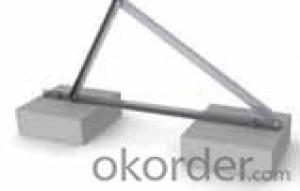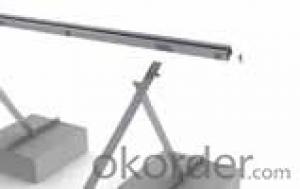Flat Roof System Solar mounting system
- Loading Port:
- China Main Port
- Payment Terms:
- TT OR LC
- Min Order Qty:
- -
- Supply Capability:
- -
OKorder Service Pledge
OKorder Financial Service
You Might Also Like
Product Features
• Adoptable to all kinds of crystalline modules and certain thin film modules.
• Direct foundation bolt , concrete base or bear load are the possible solution for ground installation.
• System installation inclination is adjustable according to requirement.
• Easy installation, only three kinds of tools could finish the installation.
1 Fix the triangular supporting frames
on the concrete base.
2 Fix the rail on the triangular
supporting frames with T-head bolt
and flange nut.
3 Locate the module clamps and put
the PV modules on the rail. Then just
need to fasten the bolt in the clamp.
Flat Roof System
Versolsolar system are being widely used
in all kinds of flat roof according to the
roof bearing capacity and waterproof
requirements. Usually we adopt load
way or chemical anchor bolt to fix the
system on the roof.
Versolsolar chooses high quality material
and good appearance, original design of
connection between al-rail and module
made the installation rapid. No second
processing to the components are
needed on site.
Insrallation site Flat roof
Module specification Frame / frameless module, silicon / film module
Installation inclination Client requirement
Module arrangement Portrait
Module area square Client arrangement
Module area position Client arrangement
Base frame AL 6063T5 / stainless steel
Small pieces Stainless steel, Al6063 T5
- Q:What is the lifespan of solar inverters?
- Solar inverters can have varying lifespans, which are influenced by several factors. On average, most solar inverters last between 10 to 15 years. However, the quality, brand, and specific model of the inverter can impact its lifespan. Lower-quality inverters tend to have shorter lifespans, while higher-quality ones can endure for 20 years or more. To extend the lifespan of solar inverters, regular maintenance and proper installation are crucial. Keeping the inverter clean, free from dust or debris, and safeguarded from extreme weather conditions can help prolong its life. It's worth noting that although the inverter's lifespan may be shorter compared to the solar panels themselves, it can be replaced relatively easily without needing to replace the entire solar system. Furthermore, as inverter technology advances, upgrading to a newer and more efficient model becomes a possibility once the initial inverter reaches the end of its life. In conclusion, while the lifespan of solar inverters can differ, with adequate maintenance and high-quality equipment, they can deliver reliable performance for a significant duration.
- Q:Can solar energy systems be used for powering mining or drilling operations?
- Yes, solar energy systems can be used to power mining or drilling operations. Solar panels can generate electricity in remote locations where it may be challenging or expensive to bring in traditional power sources. This renewable energy source can help reduce the environmental impact of mining and drilling operations by reducing reliance on fossil fuels. Additionally, solar energy systems can provide a reliable and sustainable power supply for these energy-intensive operations.
- Q:What is the impact of roof color on the performance of solar panels?
- The performance of solar panels can be significantly affected by the color of the roof, although it mainly depends on the type of solar panel technology being used. The color of the roof can have an impact on the overall efficiency and output of solar panels due to its influence on sunlight temperature and reflection. Solar radiation absorption and reflection are influenced by roof color. Dark-colored roofs tend to absorb more sunlight, resulting in increased heat accumulation on the roof's surface. This excess heat negatively affects the performance of solar panels, as they function less efficiently at higher temperatures. The elevated temperature can lead to a decrease in the overall power output of the panels, reducing their energy generation potential. On the contrary, light-colored roofs reflect more sunlight, which helps prevent excessive heat buildup. By reflecting a significant amount of solar radiation, the roof's color assists in keeping the panels cooler and maintaining their optimal operating temperature. This can lead to better performance and higher energy production from the solar panels. However, it is important to note that the impact of roof color can vary depending on the type of solar panel technology used. Certain types of solar panels, such as monocrystalline or polycrystalline, may be more sensitive to temperature changes and therefore more influenced by roof color. In contrast, thin-film solar panels are generally less affected by temperature variations, making the impact of roof color less significant in their case. Furthermore, factors like climate, local weather conditions, and the orientation and tilt of the solar panels can also have a greater impact on their performance than the roof color alone. Proper installation and maintenance of the solar panel system, including adequate ventilation and shading, can further mitigate the impact of roof color on panel performance. In conclusion, while roof color can affect the performance of solar panels, it is just one of many factors that can influence their efficiency and energy production. To maximize the performance of solar panels, regardless of the roof color, it is essential to consider the specific type of solar panel technology, local environmental conditions, and proper installation practices.
- Q:I want to install a full set of domestic solar heating equipment does not know how much money to spend, please.
- This area of solar heating system is divided into 4 parts: solar panels. Thermal energy water storage device. Thermal converter. Auxiliary heating wall. This system can be added with winter heating of buildings above 50% hot heat as a heat source for heating indoor floor heating systems, the spring and autumn three season can use gas or not using gas assisted heating (heat storage water tank can not increase the gas heating can be all-weather hot water).
- Q:Can solar energy systems be used in powering wastewater treatment plants?
- Yes, solar energy systems can be used to power wastewater treatment plants. Solar energy is a renewable and clean source of electricity that can be harnessed through the use of solar panels. These panels capture sunlight and convert it into electricity, which can then be used to power various processes within a wastewater treatment plant. There are several benefits to using solar energy systems in powering wastewater treatment plants. Firstly, solar power is abundant and available in most regions, making it a reliable source of energy. This reduces the dependence on fossil fuels and helps to mitigate the environmental impact associated with traditional energy sources. Furthermore, solar energy systems have low operational costs and require minimal maintenance compared to conventional power sources. Once the initial investment in solar panels is made, the ongoing costs are significantly lower, leading to cost savings in the long run. Solar-powered wastewater treatment plants also contribute to reducing greenhouse gas emissions. By switching to renewable energy, these plants can significantly decrease their carbon footprint and help combat climate change. Additionally, solar energy systems can be easily integrated into existing wastewater treatment plants. They can be used to power various components such as pumps, motors, and aeration systems, which are crucial for the treatment process. However, it is important to consider the specific energy requirements of each wastewater treatment plant when implementing solar energy systems. The size and capacity of the solar panels should be carefully determined to ensure they can generate enough electricity to meet the plant's needs consistently. In conclusion, solar energy systems can indeed be used to power wastewater treatment plants. They offer numerous advantages such as cost savings, reduced environmental impact, and easy integration. As the world continues to prioritize sustainable energy solutions, solar-powered wastewater treatment plants are becoming increasingly popular and are a step towards a greener and more sustainable future.
- Q:How do solar energy systems impact the electrical grid?
- Solar energy systems impact the electrical grid by injecting clean and renewable energy into the system, reducing the demand for electricity from traditional power sources. This can help lower overall electricity costs, decrease greenhouse gas emissions, and improve grid reliability and resiliency by diversifying the energy mix. However, the intermittent nature of solar power requires careful grid management to balance supply and demand, and additional infrastructure and regulatory measures may be needed to accommodate higher levels of solar energy integration.
- Q:Solar PV systems
- Fifth distributed photovoltaic power generation implementation of self occupied, power over the Internet, the nearest consumptive, power regulation, operation mode. The power grid enterprise uses advanced technology to optimize the operation and management of power grid, and provides the system support for the distributed photovoltaic power generation operation. To encourage investment business entities with the same power supply area of the power users in power grid enterprise cooperation in a variety of ways to achieve the nearest consumptive distributed photovoltaic power generation.
- Q:Can solar energy systems work during cloudy or rainy days?
- Yes, solar energy systems can still work during cloudy or rainy days, although their efficiency may be reduced. While direct sunlight is optimal for generating electricity from solar panels, they can still generate power from diffused or scattered sunlight that passes through the clouds. However, the amount of electricity generated will be less compared to sunny days. Some advanced solar technologies are designed to maximize power production even in low light conditions, ensuring a certain level of energy generation even on cloudy or rainy days.
- Q:Can solar energy systems be used in areas with limited access to solar energy regulations and policies?
- Yes, solar energy systems can still be used in areas with limited access to solar energy regulations and policies. While regulations and policies can play a crucial role in promoting and supporting the use of solar energy, they are not the sole determining factor in deploying solar energy systems. In areas with limited regulations and policies, individuals, businesses, and organizations can still invest in solar energy systems for their own use or to meet specific energy needs. Additionally, advancements in technology and decreasing costs make solar energy systems increasingly viable even in areas without extensive regulations and policies.
- Q:What is the impact of dust or dirt on solar panel efficiency?
- The impact of dust or dirt on solar panel efficiency is significant. When dust or dirt accumulates on the surface of solar panels, it acts as a barrier between sunlight and the photovoltaic cells, reducing the amount of sunlight that can be converted into electricity. This leads to a decrease in the overall efficiency of the solar panel system. Regular cleaning and maintenance of solar panels are essential to ensure optimal performance and maximize energy output.
1. Manufacturer Overview |
|
|---|---|
| Location | |
| Year Established | |
| Annual Output Value | |
| Main Markets | |
| Company Certifications | |
2. Manufacturer Certificates |
|
|---|---|
| a) Certification Name | |
| Range | |
| Reference | |
| Validity Period | |
3. Manufacturer Capability |
|
|---|---|
| a)Trade Capacity | |
| Nearest Port | |
| Export Percentage | |
| No.of Employees in Trade Department | |
| Language Spoken: | |
| b)Factory Information | |
| Factory Size: | |
| No. of Production Lines | |
| Contract Manufacturing | |
| Product Price Range | |
Send your message to us
Flat Roof System Solar mounting system
- Loading Port:
- China Main Port
- Payment Terms:
- TT OR LC
- Min Order Qty:
- -
- Supply Capability:
- -
OKorder Service Pledge
OKorder Financial Service
Similar products
New products
Hot products
Hot Searches
Related keywords































